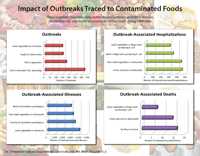Overview
Tracking and reporting the foods, germs, and settings where outbreaks occur increases our understanding of its impact on human health and is the first step towards prevention.
 Next time you go for food, consider this: roughly one in six (or 48 million) people in the United States get sick from eating contaminated food per year.1 More than 250 pathogens and toxins have been known to cause foodborne illness. Nearly all of them can cause an outbreak.2
Next time you go for food, consider this: roughly one in six (or 48 million) people in the United States get sick from eating contaminated food per year.1 More than 250 pathogens and toxins have been known to cause foodborne illness. Nearly all of them can cause an outbreak.2
A foodborne disease outbreak occurs when two or more people get the same illness from the same contaminated food or drink.2 While most foodborne illnesses are not part of a recognized outbreak, outbreaks provide important information on how germs spread, which foods cause illness, and how to prevent infection.3
Why Information from Outbreaks is Important
It may seem like it should be straightforward to determine the food sources responsible for illnesses, but it is more complicated than you might think. This is because it is usually not possible to know which food made an individual person sick, or to know if a food was responsible for the illness. People rarely know what made them ill, and it can be difficult or impossible to figure out.4
When a group of people become ill at the same time in a foodborne outbreak, investigation may sometimes determine which food was responsible, providing a direct link between the foodborne illnesses and a food. This information is difficult to gather outside of an outbreak.4
Public health officials investigate outbreaks to control them, so more people do not get sick in the outbreak, and to learn how to prevent similar outbreaks from happening in the future.
Learn about the CDC’s Foodborne Disease Outbreak Surveillance System
Reporting Foodborne Disease Outbreaks
Public health agencies in all 50 states, the District of Columbia, U.S. territories, and Freely Associated States have primary responsibility for identifying and investigating outbreaks and use a standard form to report outbreaks voluntarily to CDC. During 1998–2008, reporting was made through the electronic Foodborne Outbreak Reporting System (eFORS).5
Decades of Data
National surveillance for foodborne and waterborne disease outbreaks has been a core function of CDC since the 1970s. Two surveillance systems handle this responsibility: the Waterborne Disease and Outbreak Surveillance System (1971-present), and the Foodborne Disease Outbreak Surveillance System (1973-present)
- Page last reviewed: November 2, 2015
- Page last updated: November 2, 2015
- Content source:


 ShareCompartir
ShareCompartir

